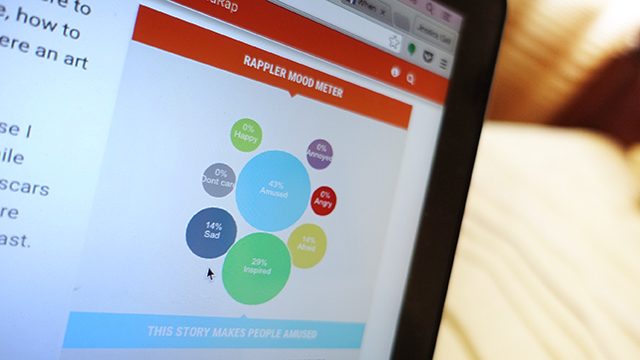SUMMARY
This is AI generated summarization, which may have errors. For context, always refer to the full article.

MANILA, Philippines – Researchers Marco Guerini at Trento Rise in Italy and Jacopo Staiano at Sorbonne Université in Paris studied the data from news websites Rappler and Corriere.it to find out if a relationship exists between virality and the emotions a story elicits.
According to the study, Deep feelings: A massive cross-lingual study on the relation between emotions and virality, psychologists used the Valence-Arousal-Dominance model as one means of categorizing emotions.
Valence refers to how positive or negative an emotion is while arousal determines how high (such as anger) or low (like sadness) a level it is felt.
Dominance, meanwhile, determines how much control a person has over their emotions, with one end of the spectrum being emotionally overwhelming, such as fear. The other end is one that people choose to experience, such as with feelings of inspiration.
Combined, the 3 parts determine a 3-dimensional model of emotion, and Guerini and Staiano think the parameters on the 3D space determine what makes a story that elicits emotion viral.
Emotion and virality
The researchers studied 65,000 Rappler and Corriere.it stories in total, measuring the studies by counting the comments each story made.
They also looked at the number of votes the stories received on social media sites like Facebook and Google+.
Guerini and Staiano posit that a clear link exists between virality and specific parameters for valence, arousal and dominance.
The configurations, they noted, “indicate a clear connection with distinct phenomena underlying persuasive communication.”
Commenting versus voting
Guerini and Staiano also noted differences in what emotions drove commenting behavior versus social voting.
According to their study, valence did little to sway a person to vote or comment, with arousal and control causing votes and comments to appear.
Posts received more comments when they were associated with high arousal emotions – anger or happiness – or emotions that made people feel less in control – such as fear and sadness.
Social votes were more associated with emotions where people felt more control, such as inspiration.
Guerini and Staiano also used Rappler as the basis for an automated system to extract a high-coverage and high-precision lexicon of roughly 37,000 terms annotated with emotion scores. – Rappler.com
Add a comment
How does this make you feel?
There are no comments yet. Add your comment to start the conversation.